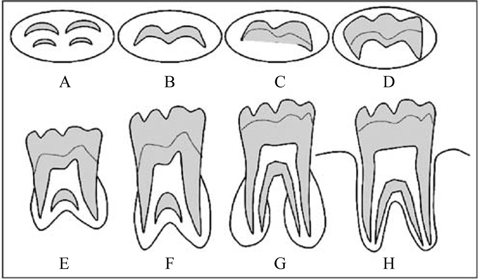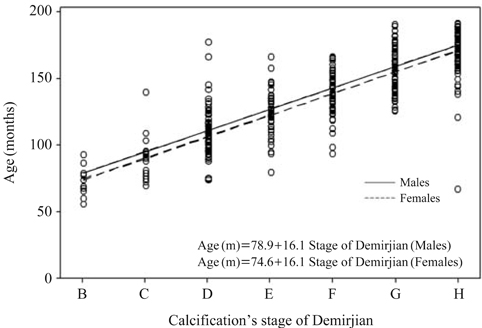Imaging Sci Dent.
2013 Mar;43(1):1-6. 10.5624/isd.2013.43.1.1.
The chronology of second molar development in Brazilians and its application to forensic age estimation
- Affiliations
-
- 1Department of Clinic and Social Dentistry, School of Dentistry, Federal University of Paraiba, Joao Pessoa, Brazil. manuellacarneiro@hotmail.com
- 2Department of Oral Medicine, Division of Oral Radiology, Pernambuco Dental School, Pernambuco University-UPE, Camaragibe, Brazil.
- 3Department of Clinical and Social Dentistry, Division of Oral Radiology, Federal University of Pernambuco, Recife, Brazil.
- KMID: 2167440
- DOI: http://doi.org/10.5624/isd.2013.43.1.1
Abstract
- PURPOSE
This study investigated the possible correlation between the mineralization of the second molars and the chronological age of a sample population of the state of Paraiba, Brazil.
MATERIALS AND METHODS
One thousand eight hundred fifty-four digitized panoramic images using a scanner of a private dental radiology service were obtained in six months. Of these, 457 were selected from patients aged 4.6 to 16 years who met certain criteria. The images were assessed twice by a radiologist with 5 years experience. A minimum interval of 30 days between the evaluations of the same patient was established. To analyze the relationship between chronological age, calcification level proposed by Demirjian et al in 1973, gender, and tooth, a multiple linear regression model was adjusted, taking age as the response variable (p<0.05).
RESULTS
The gender and calcification level were significantly correlated with the age of the patients (p<0.05). There was a significant difference between the average age of the patients' upper teeth compared to the lower ones in both genders (p<0.05). The dental development occurred earlier in female individuals than in male ones, and there was no significant difference between the right and left second permanent molars.
CONCLUSION
It was observed that ethnic variables are related to certain parameters of age and sex identification in the Brazilian population, providing important information for forensic evaluations.
MeSH Terms
Figure
Cited by 2 articles
-
Development of dental charts according to tooth development and eruption for Turkish children and young adults
Beytullah Karadayı, Hüseyin Afşin, Abdi Ozaslan, Şükriye Karadayı
Imaging Sci Dent. 2014;44(2):103-113. doi: 10.5624/isd.2014.44.2.103.Radiographic evaluation of third molar development in 6- to 24-year-olds
Yun-Hoa Jung, Bong-Hae Cho
Imaging Sci Dent. 2014;44(3):185-191. doi: 10.5624/isd.2014.44.3.185.
Reference
-
1. Bagherpour A, Imanimoghaddam M, Bagherpour MR, Einolghozati M. Dental age assessment among Iranian children aged 6-13 years using the Demirjian method. Forensic Sci Int. 2010. 197:121.e1–121.e4.
Article2. Koshy S, Tandon S. Dental age assessment: the applicability of Demirjian's method in south Indian children. Forensic Sci Int. 1998. 94:73–85.
Article3. Demirjian A, Goldstein H, Tanner JM. A new system of dental age assessment. Hum Biol. 1973. 45:211–227.4. Chaillet N, Nyström M, Kataja M, Demirjian A. Dental maturity curves in Finnish children: Demirjian's method revisited and polynomial functions for age estimation. J Forensic Sci. 2004. 49:1324–1331.
Article5. Bagherian A, Sadeghi M. Assessment of dental maturity of children aged 3.5 to 13.5 years using the Demirjian method in an Iranian population. J Oral Sci. 2011. 53:37–42.
Article6. Chen JW, Guo J, Zhou J, Liu RK, Chen TT, Zou SJ. Assessment of dental maturity of western Chinese children using Demirjian's method. Forensic Sci Int. 2010. 197:119.e1–119.e4.
Article7. Choi JH, Kim CY. A study of correlation between the development of the third molar and second molar as an aid in age determination. J Korean Acad Oral Med. 1991. 16:121–136.8. Nyström M, Aine L, Peck L, Haavikko K, Kataja M. Dental maturity in Finns and the problem of missing teeth. Acta Odontol Scand. 2000. 58:49–56.
Article9. Jayaraman J, King NM, Roberts GJ, Wong HM. Dental age assessment: are Demirjian's standards appropriate for southern Chinese children? J Forensic Odontostomatol. 2011. 29:22–28.10. Karataş OH, Öztürk F, Dedeoğlu N, Çolak C, Altun O. Dental age assessment: the applicability of Demirjian method in southwestern of eastern Anatolia region Turkish children. Cumhuriyet Dent J. 2012. 15:130–137.
Article11. Phillips VM, van Wyk Kotze TJ. Testing standard methods of dental age estimation by Moorrees, Fanning and Hunt and Demirjian, Goldstein and Tanner on three South African children samples. J Forensic Odontostomatol. 2009. 27:29–44.12. Phillips VM, van Wyk Kotze TJ. Dental age related tables for children of various ethnic groups in South Africa. J Forensic Odontostomatol. 2009. 27:20–28.13. Willems G, Van Olmen A, Spiessens B, Carels C. Dental age estimation in Belgian children: Demirjian's technique revisited. J Forensic Sci. 2001. 46:893–895.
Article14. Shim WH, Kim KS, Shin KJ, Yoon CL, Kim CY, Choi JH. Second and third molar calcification in relation to chronological age in Koreans. J Korean Acad Oral Med. 2004. 29:329–340.15. Lee SS, Byun YS, Park MJ, Choi JH, Yoon CL, Shin KJ. The chronology of second and third molar development in Koreans and its application to forensic age estimation. Int J Legal Med. 2010. 124:659–665.
Article16. Thevissen PW, Pittayapat P, Fieuws S, Willems G. Estimating age of majority on third molars developmental stages in young adults from Thailand using a modified scoring technique. J Forensic Sci. 2009. 54:428–432.
Article17. Meinl A, Tangl S, Huber C, Maurer B, Watzek G. The chronology of third molar mineralization in the Austrian population -a contribution to forensic age estimation. Forensic Sci Int. 2007. 169:161–167.18. Schmeling A, Reisinger W, Geserick G, Olze A. Age estimation of unaccompanied minors. Part I. General considerations. Forensic Sci Int. 2006. 159:Suppl 1. S61–S64.19. Nolla CM. The development of permanent teeth. J Dent Child. 1960. 4:254–266.20. Moyers RE. Handbook of orthodontics for the student and general practitioner. 1973. 3rd ed. Chicago: Year Book Medical.21. Lee SE, Lee SH, Lee JY, Park HK, Kim YK. Age estimation of Korean children based on dental maturity. Forensic Sci Int. 2008. 178:125–131.
Article22. Holtgrave EA, Kretschmer R, Müller R. Acceleration in dental development: fact or fiction. Eur J Orthod. 1997. 19:703–710.
Article
- Full Text Links
- Actions
-
Cited
- CITED
-
- Close
- Share
- Similar articles
-
- Age Estimation Based on Mandibular Premolar and Molar Development: A Pilot Study
- DNA Methylation-Based Age Estimation in the Forensic Field
- Forensic Application of Age Estimation Using Signal Joint T-Cell Receptor Excision Circles in Human Lymphoid Tissues
- Drusini's and Takei's Methods for Age Estimation in Korean Adults
- The Application of Paewinsky et al.'s Age Estimation Method to Periapical Radiographs




